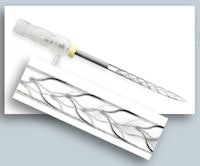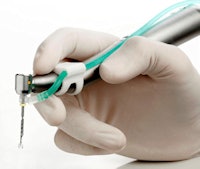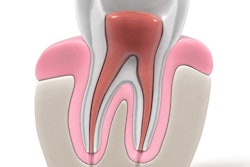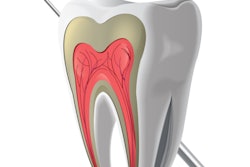
An endodontic technology system called the Self-Adjusting File (SAF), developed by ReDent Nova and distributed by Henry Schein Dental through its Endovations group, offers a unique approach to root canal therapy that allows clinicians to use a single instrument instead of an array of hand files to simultaneously clean, shape, and irrigate the canal.
"It's like an accordion that can expand or contract according to the shape of the canal," said Stephen Cohen, DDS, a professor of endodontics at the University of California, San Francisco, School of Dentistry, during a presentation March 5 at the Western Regional Dental Convention in Phoenix.
“It's like an accordion that can expand or contract according to the shape of the canal.”
— Stephen Cohen, DDS, University of
California School of Dentistry
The technology features a mechanically operated, medical-grade nickel-titanium-alloy file designed as a hollow, cylinder lattice with an abrasive surface for the filing of dentin from the root canal's interior surface.
Unlike the turning of a conventional rotary system, the SAF's open lattice moves in an oscillating up-and-down motion, with a vertical vibration of 3,000 to 5,000 oscillations per minute. The file self-adjusts to the canal's natural 3D anatomy while an integral irrigator continuously delivers irrigation throughout the canal.
 The SAF design features longitudinal beams connected by arches, forming a pointed cylinder with a 1.5-mm diameter midinstrument, with approximately 0.2 mm at tip. The arches are stabilized by thin longitudinal struts.
The SAF design features longitudinal beams connected by arches, forming a pointed cylinder with a 1.5-mm diameter midinstrument, with approximately 0.2 mm at tip. The arches are stabilized by thin longitudinal struts.
The multitasking system automatically adjusts to fit the entire cross section of a canal that has had the glide path prepared to a No. 20 file size, allowing for precision in canal shaping and debridement, according to Endovations.
The file's circumferential pressure results in a gradual removal of a thin, uniform, hard-tissue layer from the root canal surface, enlarging but retaining the root canal's original shape, regardless of whether the canal is oval, flat, or C-shaped, Dr. Cohen explained.
"Think of it as sandpaper against all the walls of the canal providing equal force, and during the time the SAF is employed, it will remove approximately 250 microns of the inner dentin," he said.
Importantly, the SAF has a substantially lower risk of breakage, compared with conventional files, and in fact "virtually eliminates" the file breakage problem, according to Endovations. Smaller sections of the file's lattice may divide, Dr. Cohen noted, but when there is a break, it is typically only a fragment of the lattice, as opposed to a file separation.
"The SAF isn't perfect because the lattice can unravel, but even if a fragment of the lattice breaks off in the canal, you can simply use a No. 20 file and just lift it right out," he explained. "In the two years that I've been using the SAF, I have not once separated an instrument. Several have unraveled, but there was no harm done."
Clinical research
Several studies have shown that the SAF's continuous irrigation provides for improved disinfection of the canal, compared with rotary systems. One study comparing the two systems in 20 long, oval-shaped root canals found that Entercoccus faecalis was isolated in 11 of 20 teeth, or 55%, following cleaning and shaping with a rotary system, whereas the bacteria was present in only four of 20 teeth, or 20%, following cleaning with the SAF system (Journal of Endodontics [JOE], November 2010, Vol. 36:11, pp. 1860-1865).
 The SAF file with its irrigation tube attached to a KaVo handpiece.
The SAF file with its irrigation tube attached to a KaVo handpiece.
Another study, also involving 20 root canals, found that canal walls that were free of debris in all thirds of the canal in all samples, and smear layer-free surfaces were observed in 100% and 80% of the coronal and middle thirds of the canal, respectively, in canals that were cleaned and shaped with the SAF using sodium hypochlorite (3%) and ethylenediaminetetraacetic acid (EDTA) (17%). In the apical third of the canal, smear layer-free surfaces were found in 65% of the root canals (JOE, April 2010, Vol. 36:4, pp. 697-702).
"Not only does the SAF remove all of the debris, but it eliminates the smear layer and opens all of the lateral accessory canals, providing far better disinfection," said Dr. Cohen, who disclosed that while his talk at the Western Regional meeting was supported by Endovations, he has no financial interests with Henry Schein Dental.
The SAF is employed for four minutes per canal, and one instrument is used per tooth, regardless of the number of canals.
"The instruments will last up to 30 minutes, so even if you find six root canals in a molar -- and yes, there is a documented case of that -- the one instrument will take care of all of the canals in that tooth," Dr. Cohen said.
The SAF system is available in three lengths: 21, 25, and 31 mm, and it comes in packages of three to 10 instruments. The standard introductory kit, including one 25-mm SAF 10-pack, sells for about $2,500, and various bulk packages are priced in the $6,000 to $7,000 range.
In response to a question from an attendee on SAF's efficacy on retreated root canals, Dr. Cohen said that not only can the system be used on retreated root canals, but "nearly half of the cases I use the SAF on are retreated root canals."



















